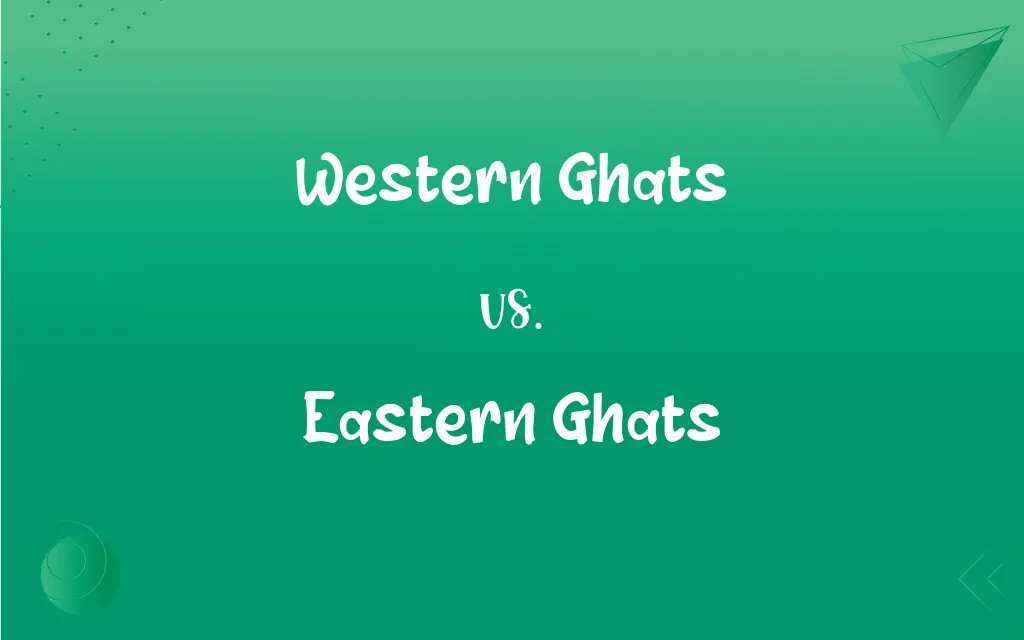Western Ghats vs. Eastern Ghats: What's the Difference?
Edited by Aimie Carlson || By Harlon Moss || Published on February 25, 2024
The Western Ghats are a biodiverse, higher, and wetter mountain range along India's west coast, while the Eastern Ghats are lower, drier, and less continuous, located along the east coast.

Key Differences
The Western Ghats, a UNESCO World Heritage Site, are a mountain range running parallel to India's western coast, known for their rich biodiversity and significant endemism. The Eastern Ghats, on the other hand, are a discontinuous range of hills running along India's eastern coast, less celebrated for biodiversity but important for mineral resources and distinct ecosystems.
Climatically, the Western Ghats experience heavy rainfall due to the Southwest monsoon, creating lush forests and a plethora of waterfalls. The Eastern Ghats, being on the leeward side, receive comparatively less rainfall, resulting in a drier vegetation pattern and differing ecological characteristics.
Geologically, the Western Ghats are older and more eroded, formed mainly of basalt and laterite, supporting a rich array of flora and fauna. The Eastern Ghats comprise a variety of rock formations, including khondalites and charnockites, and are known for their mineral wealth.
The Western Ghats host several hill stations and are known for their tea and coffee plantations, contributing significantly to India's plantation economy. In contrast, the Eastern Ghats, though less prominent as a tourist destination, are crucial for agriculture and are dotted with important temples and historical sites.
Biodiversity is a notable aspect of the Western Ghats, home to numerous endemic species, including the lion-tailed macaque and the Nilgiri tahr. The Eastern Ghats, while less diverse, are important for their unique species like the Jerdon's courser and house several wildlife sanctuaries and biosphere reserves.
ADVERTISEMENT
Comparison Chart
Location
Along India's west coast
Along India's east coast
Elevation
Higher, with peaks like Anamudi
Generally lower
Rainfall
Receives heavy rainfall from Southwest monsoon
Receives less rainfall
Biodiversity
Richer, with many endemic species
Lesser biodiversity, but unique species
Economic Contribution
Known for tea and coffee plantations
Rich in mineral resources
ADVERTISEMENT
Western Ghats and Eastern Ghats Definitions
Western Ghats
Known for hill stations like Munnar and Ooty.
Munnar, in the Western Ghats, is famous for its sprawling tea gardens.
Eastern Ghats
These hills are known for agricultural significance.
The Eastern Ghats provide vital resources for the agricultural activities of the surrounding areas.
Western Ghats
The Ghats are home to unique species like the lion-tailed macaque.
The Western Ghats' dense forests are the only habitat for the endangered lion-tailed macaque.
Eastern Ghats
They receive less rainfall and have distinct ecological characteristics.
The dry deciduous forests in the Eastern Ghats are home to diverse wildlife.
Western Ghats
A mountain range along India's western coast, known for its biodiversity.
The Western Ghats are a hotspot for ecotourism due to their diverse flora and fauna.
Eastern Ghats
A discontinuous range of hills along India's eastern coast.
The Eastern Ghats are known for their scenic beauty and rich cultural heritage.
Western Ghats
This range is crucial for the monsoon patterns in peninsular India.
The Western Ghats play a significant role in bringing the monsoon rains to south India.
Eastern Ghats
The Ghats are important for mineral resources like bauxite.
The bauxite mines in the Eastern Ghats are a major source of revenue for the region.
Western Ghats
The Western Ghats are a UNESCO World Heritage Site, comprising several national parks.
The Silent Valley National Park in the Western Ghats is a critical area for tiger conservation.
Eastern Ghats
The Eastern Ghats host important temples and historical sites.
The ancient temple at Tirupati is located in the Eastern Ghats.
FAQs
What is the significance of the Eastern Ghats in agriculture?
The Eastern Ghats are important for agriculture, providing resources and suitable climate for various crops.
What are the Western Ghats?
The Western Ghats are a mountain range along India's west coast, noted for their biodiversity.
What are the Eastern Ghats?
The Eastern Ghats are a discontinuous range of hills along India's east coast, known for their mineral resources.
How do the climates of the Western and Eastern Ghats differ?
The Western Ghats have a wet climate due to heavy monsoon rains, whereas the Eastern Ghats are drier.
Are the Western Ghats a UNESCO World Heritage Site?
Yes, parts of the Western Ghats are recognized as a UNESCO World Heritage Site for their ecological importance.
What unique species can be found in the Western Ghats?
The Western Ghats are home to unique species like the lion-tailed macaque and Nilgiri tahr.
Are the Eastern Ghats rich in biodiversity?
The Eastern Ghats have a distinct biodiversity, though not as rich as the Western Ghats.
What are some popular tourist destinations in the Western Ghats?
Popular destinations in the Western Ghats include hill stations like Munnar and Ooty.
Do the Eastern Ghats contribute to India's mineral wealth?
Yes, the Eastern Ghats are a significant source of minerals like bauxite and iron ore.
Are there any cultural sites in the Western Ghats?
Yes, the Western Ghats host several cultural and historical sites, including ancient temples and forts.
How do the Western Ghats affect the monsoon in India?
The Western Ghats play a crucial role in influencing the monsoon patterns in peninsular India.
Are the Eastern Ghats important for water resources?
Yes, the Eastern Ghats play a role in water resource management for the surrounding areas.
Are there national parks in the Eastern Ghats?
Yes, there are several national parks and wildlife sanctuaries in the Eastern Ghats.
What is the role of the Western Ghats in India's ecosystem?
The Western Ghats are vital for maintaining ecological balance, supporting numerous species and watersheds.
What is the main difference in elevation between the Western and Eastern Ghats?
The Western Ghats are generally higher with more prominent peaks compared to the Eastern Ghats.
What type of forests are found in the Eastern Ghats?
The Eastern Ghats have a mix of dry deciduous and tropical forests.
Do the Eastern Ghats have any endangered species?
Yes, the Eastern Ghats are home to endangered species like the Jerdon's courser.
How do the Western Ghats contribute to India's economy?
The Western Ghats contribute through tea and coffee plantations, ecotourism, and hydroelectric power.
What is the geological makeup of the Western Ghats?
The Western Ghats consist mainly of basalt and laterite formations.
How do the Western and Eastern Ghats differ in terms of tourism?
The Western Ghats are more popular for ecotourism and hill stations, while the Eastern Ghats attract visitors for their temples and historical significance.
About Author
Written by
Harlon MossHarlon is a seasoned quality moderator and accomplished content writer for Difference Wiki. An alumnus of the prestigious University of California, he earned his degree in Computer Science. Leveraging his academic background, Harlon brings a meticulous and informed perspective to his work, ensuring content accuracy and excellence.
Edited by
Aimie CarlsonAimie Carlson, holding a master's degree in English literature, is a fervent English language enthusiast. She lends her writing talents to Difference Wiki, a prominent website that specializes in comparisons, offering readers insightful analyses that both captivate and inform.































































